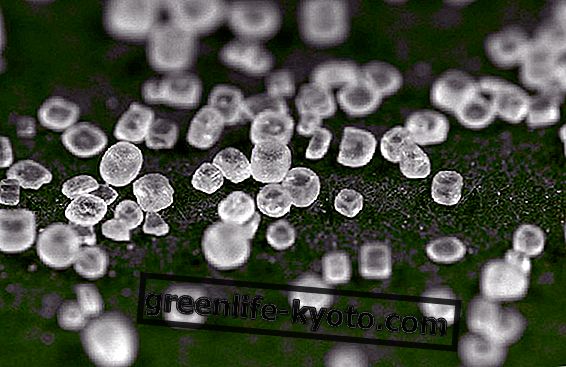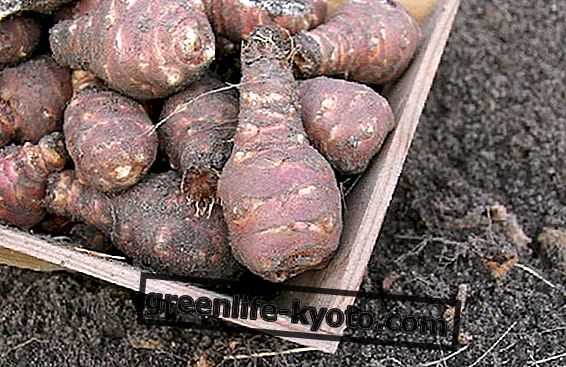
The liliaceae family includes a group of monocotyledonous plants that are part of the genus Liliales .
Usually they are bulbous or rhizomatous plants that have the leaves of a commonly filiform, lanceolate or oblong form but always with quite fleshy parallel ribs.
This family of plants is very ancient and it seems that its origin dates back to about 58 million years ago when the plants have developed the bulb or rhizome as an adaptation to better survive during periods of nutrient shortage; in fact these two systems allowed to have reserves of nutrients even when the climate was too rigid or there was too much drought.
In the ancient systematic criterion of cataloging plants, over 4000 species were indicated in the liliaceae family; in this infinite variety, the most common food liliacea are asparagus, garlic, onion, leek, chives and shallots .
In this family many plants are then used for their beauty and therefore for ornamental purposes such as lily of the valley, hyacinth, lily and tulip.
But among the minor liliacee we go to know the lampascioni, the wild garlic, the wild little garlics and the black garlic .
The lampascioni
The scientific name of the lampascione plant is Muscari Comosum and belongs to the Lilliaceae family.
This small bulb grows spontaneously in Italy and is especially harvested in the southern regions such as Puglia and Basilicata .
The lampascioni can be easily recognized thanks to their particular purple inflorescence that blooms in spring and just this flower was once used to dye the fabrics .
The edible part instead of the plant is the bulb that grows at a depth of about 15 centimeters below the ground level.
The lampascioni can also be cultivated but the spontaneous ones with a more marked bitter taste are certainly more sought after and appreciated . Usually before harvesting the lampascione bulb, it is expected at least 4 or 5 years so that it is large enough and ripe to be eaten.
Those who have no experience in recognizing it, must never abstain from harvesting because they could find another spontaneous bulb, Colchico, which is highly poisonous.
Properties of lampascioni
Lampascioni contain dietary fiber, starch and sugars such as sucrose and glucose but also many minerals such as potassium, calcium, phosphorus, iron, copper, manganese and magnesium.
They also have healthy active ingredients such as flavonoids, saponins and various nitrogen compounds that give this bulb its typical flavor; the presence of these substances makes the lampascioni diuretics and slightly laxatives with an antithrombotic effect thanks to the ability to lower the blood pressure and decrease the circulating fats.
The bitter taste is indicated to help digestion and in addition the lampascioni have an anti-inflammatory effect on the digestive walls and on the mucosa of the intestine.

Discover the other bitter herbs to purify the liver
Wild garlic
Wild garlic is an edible medicinal plant that bears the scientific name of Allium ursinum and belongs to the liliaceae family.
Wild garlic is a perennial herbaceous plant that grows up to a maximum of 40 centimeters and has broad basal leaves with a fleshy consistency; the flowers are white umbels inflorescences that bloom in spring from the month of April. The bulb that grows underground is edible and its taste and smell is typical of garlic .
Wild garlic grows spontaneously throughout Italy in the shady areas of broad-leaved forests or along streams because it loves damp places. This garlic is widespread both in Europe and in northern Asia.
The ramson bulb can be used fresh or dried ; even its leaves are edible in the same way as salad and even the seeds can be picked and used as a spice to flavor dishes .
Properties of wild garlic
Wild garlic is a medicinal plant that has been used in folk medicine for a very long time to help the well-being of the organism.
In fact it allows to lower cholesterol in the blood being hypocholesterolizing and protects against heart diseases ; it has purifying and antiseptic properties, being a blood purifier and an excellent detoxifier from microorganisms, parasites, fungi and pathogenic bacteria as well as heavy metals and other toxic substances.
Wild garlic, like other garlic, has hypotensive, vasodilatory and diuretic properties .
Discover the hair benefits of wild garlic tea

Wild garlic
Whoever collects wild plants for food use knows well the so-called wild little birds that grow in the early spring in the fresh woods of the plains and that bloom in graceful inflorescences of white or pale pink.
These tasty small bulbs are generally referable to the scientific name of Allium neapolitanum, popularly also remembered with the name of Neapolitan or wild aietti .
The wild garlics are easy to recognize even when only the long and fleshy leaf is present because, if it is cut, it releases a strong smell of garlic; in fact, all parts of the plant contain sulphurous substances that give the typical smell of traditional garlic .
The bulbs are thus collected to be used fresh in the mesticanze and to flavor the dishes; even the leaves can be used even if they have a less intense taste than the bulb. In addition to the bulb and the leaves also the fruits are edible, red capsules that develop in the part below the flower right after the fall of the inflorescence.
The fruits of wild garlic are to be consumed during the day or kept in the refrigerator for a few days. Their flavor is typical of garlic and is very pleasant in sauces, sauces and savory creams.
Properties of wild eels
The properties of wild garlic resemble those of other plants of the same genus: hypotensive, antibiotic, antiseptic, disinfectant, hypoglycemic and digestive.

Black garlic
Black garlic was born in 2004 in Korea and subsequently spread to Europe and America. In Italy however it is not yet known and it is difficult to find it for sale while on the web we can already find it on the market.
Its black color is formed after a controlled-temperature fermentation process that lasts 30 days and after another 45-day phase.
No chemicals, additives or dyes are used, but simply garlic changes its color from white to black after these natural fermentation and oxidation processes.
Black garlic contains much more protein and mineral salts (even twice the phosphorus content and 7 times more calcium than common garlic). In Japan it is in fact considered a super-food that can give strength and fight fatigue.
Black garlic loses most of the allicin, the typical substance of traditional garlic flavor; the taste of black garlic is therefore very pleasant, almost sweet with a slight aftertaste reminiscent of licorice.
Properties of black garlic
Even without allicin, black garlic has a higher percentage of antioxidant substances that fight free radicals and prevent aging. Moreover, thanks to these antioxidants, it protects against diseases of the cardiovascular system and is useful against bad cholesterol thanks to its hypocholesterolizing effect given by the sulphurous substances it contains.
According to recent studies, black garlic has a double concentration of antioxidants compared to white garlic, with a significant increase also in cancer prevention .
Garlic: properties and benefits of natural antibiotic













